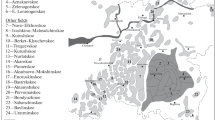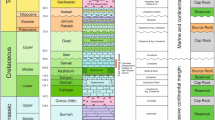Abstract—
Oils in Tatarstan were determined to have been generated in at least two source rock formations, whose organic matter (OM) differed in genesis, redox conditions of sedimentation, and maturity. The oils of type 1 are hosted in Devonian terrigenous reservoir rocks, whereas the oils of type 2 occur in overlying reservoirs. Differences between the oils are reliably identified in most compositional parameters of saturated biomarkers, with the values of the two oil groups not overlapping for two parameters: Ts/Tm and t22/t21. The maturity of the group-1 oils is statistically significantly higher than that of the group-2 ones. The source rocks are identical at the macrolevel: the original organic matter was deposited in marine sedimentation environments under reducing conditions, which is consistent with literature data. Comparison of the compositions of the oils and OM of the Domanik Formation indicates that rocks of the Mukhanovo–Erokhov trough were not involved in producing oil accumulations in Tatarstan. Differences were also detected between genetic characteristics of oils from the terrigenous Devonian rocks and Domanik Formation in the arch part of the area. Organic matter in the arch part of the territory could be significantly involved in the generation of oil accumulations hosted in reservoirs in the Semiluk and higher horizons. It is demonstrated that earlier conclusions that the source rocks of certain oil groups differed in lithology are groundless. To estimate the confidence interval for the median values, a criterion of signs was proposed, which has never before been employed in organic geochemistry.




Similar content being viewed by others
REFERENCES
Z. Aizenshtat, S. Feinshtein, I. Miloslavski, Z. Yakubson, and C. I. Yakubson, “Oil–oil correlation and potential source rocks in the Tatarian and Perm basin, Russia,” Org. Geochem. 29 (1–3), 701–712 (1998).
O. A. Aref’ev, M. N. Zabrodina, G. V. Rusinova, and Al. A. Petrov, “Biomarkers of oils of the Volga–Ural petroleum province, Neftekhimiya, 34 (6), 483–502 (1994).
L. N. Bol’shev and N. V. Smirnov, Tables of Mathematical Statistics (Nauka, Moscow, 1983) [in Russian].
E. M. Galimov and A. I. Kamaleeva, “Source of hydrocarbons in the supergiant Romashkino oilfield (Tatarstan): recharge from the crystalline basement or source sediments?” Geochem. Int. 53 (2), 95–112 (2015).
G. N. Gordadze and V. I. Tikhomirov, “Geochemical characteristics of oils and dispersed organic matter from the rocks of the central Volga–Ural Basin: hydrocarbon biomarker data,” Geochem. Int. 43 (11), 1108–1123 (2005).
G. N. Gordadze and V. I. Tikhomirov, “On the oil sources in the northeast of Tatarstan,” Petrol. Chem. 47 (6), 389–398 (2007).
G. P. Kayukova, L. Z. Nigmedzyanova, G. V. Romanov, N. S. Sharipova, V. M. Smelkov, M. V. Dakhnova, T. P. Zheglova, and E. V. Khramova, “The composition and distribution of biomarker hydrocarbons in oils and bitumens from the Bavly area of the South–Tatarian Arch,” Petrol. Chem. 44 (6), 407–415 (2004).
G. P. Kayukova, A. M. Minnegalieva, A. G. Romanov, A. M. Kiyamova, N. S. Sharipova, V. M. Smelkov, M. V. Dakhnova, and G. S. Nechitailo, “Differentiation of Romashkino crude oils according to biomarker hydrocarbon parameters,” Petrol. Chem. 46 (5), 314–323 (2006).
Yu. A. Kiseleva and S. V. Mozhegova, “Genetic oil groups of the central areas of the Volga–Urals petroleum province and their generation sources,” Neftegaz. Geol. Teor. Praktika, 7 (5), 1–16(2012).
Yu. A. Kiseleva, T. P. Zheglova, M. V. Dakhnova, S. V. Mozhegova, E. S. Nazarova, and G. S. Nechitailo, “The role of domanik deposits in the formation of oil pools in the central areas of the Volga–Ural petroleum province (Buzuluk depression),” Russ. Geol. Geophys. 58 (3–4), 310–321 (2017).
I. A. Larochkina, Geological Principles of Prospecting and Exploration of Petroleum Fields in the Republic of Tatarstan (Gart, Kazan, 2008) [in Russian].
Oil and Gas Deposits of the USSR. A Handbook. Volume 1. European USSR, Ed. by S. P, Maksimova (Nedra, Moscow, 1987) [in Russian].
A. I. Orlov, Applied Statistics. Textbook for Higher Education (Ekzamen, Moscow, 2007) [in Russian].
K. E. Peters, C. C. Walters, and J. M. Moldovan, The Biomarker Guide. Second edition. Biomarkers and Isotopes in Petroleum Systems and Earth History (Cambridge University Press, 2005).
Petroleum Potential of the Republic of Tatarstan. Geology and Exploitation of Oil Deposits, Ed. by R. Kh. Muslyumova (Fen, Kazan, 2007), vol. 1 [in Russian].
M. B. Smirnov, Principles of Proceeding of Experimental Data. A Course of Lecture. A Handbook for foe Chemists and Geochemists (INKHS RAN, Moscow, 2013) [in Russian]. http://www.ips.ac.ru/images/stories/docs/ Smirnov_part3.pdf
M. B. Smirnov and E. N. Poludetkina, “Characteristics of sources of oils of Romashkino field by composition of saturated and aromatic biomarkers,” Geochem. Int. 56 (2), 162–170 (2018).
M. B. Smirnov and N. A. Vanyukova, “Distribution patterns of main structural-group parameters of crude oils from the Volga–Urals oil and gas basin according to NMR data,” Petrol. Chem. 55 (8), 618–631 (2015).
M. B. Smirnov, and N. P. Fadeeva, “On question of informativeness of mass-spectrometral diagnostic ratios and criteria on their basis for verification of geochemical hypotheses,” Mass–spectrometriya 16 (1), 73–78 (2019).
M. B. Smirnov, N. A. Vanyukova, and E. N. Poludetkina, “Correlation of basic 1H and 13C NMR–measurable structural group parameters of crude oils of the Volga–Urals oil and gas basin,” Petrol. Chem. 56 (7), 552–561 (2016).
M. B. Smirnov, N. P. Fadeeva, R. S. Borisov, and E. N. Poludetkina, “The characteristics of the organic matter of the Upper Devonian Domanik-type deposits in the northern and central regions of the Volga–Ural Basin according to saturated biomarkers composition,” Geochem. Int. 56 (8), 812–827 (2018a).
M. B. Smirnov, N. P. Fadeeva, and E. N. Poludetkina, “Identification of the genetic heterogeneity of Tatarstan oils based on the composition of alkyl–substituted aromatic compounds,” Russ. Geol. Geophys. 59 (9), 1137–1148 (2018b).
T. N. Yusupova, Yu. M. Ganeeva, A. Z. Tukhvatullina, G. V. Romanov, R. Kh. Muslimov, and M. P. Kruglov, “Composition of oils in Vereiskian and Bashkirian carbonate reservoirs of the Akanskoe oilfield in the Republic of Tatarstan,” Petrol. Chem. 52 (4), 215–220 (2012).
Funding
This study was carried out under a government-financed research project for the Topchiev Institute of Petrochemical Synthesis, Russian Academy of Sciences.
Author information
Authors and Affiliations
Corresponding authors
Additional information
Translated by E. Kurdyukov
Rights and permissions
About this article
Cite this article
Smirnov, M.B., Fadeeva, N.P. & Vanyukova, N.A. Differentiation of Oils in Tatarstan Based on the Composition of Saturated Biomarkers. Geochem. Int. 59, 501–515 (2021). https://doi.org/10.1134/S0016702921050074
Received:
Revised:
Accepted:
Published:
Issue Date:
DOI: https://doi.org/10.1134/S0016702921050074




